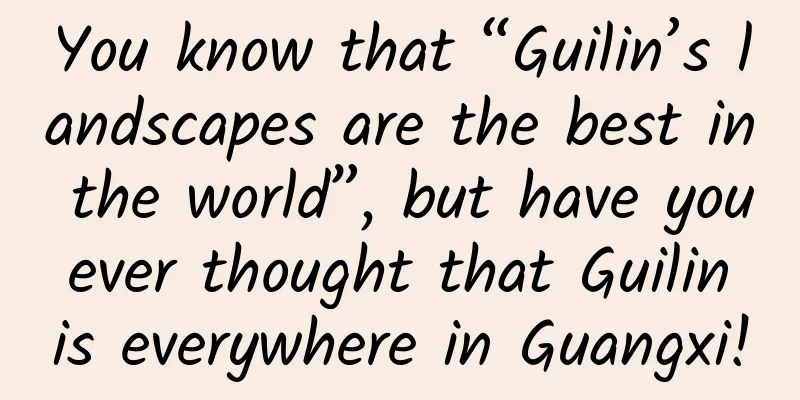You know that “Guilin’s landscapes are the best in the world”, but have you ever thought that Guilin is everywhere in Guangxi!

|
The richness of Guangxi More than you think You must know that "Guilin's landscape is the best in the world" I didn’t expect that Guangxi is full of Guilin Liuzhou snail rice noodle, Guilin rice noodle Already conquered your stomach I didn't expect there is still Laoyou rice noodles, Niuba rice noodles, pig's trotter rice noodles... 44 kinds of special rice noodles that you can't stop looking at and eating (Guangxi specialty rice noodles, only part of the display, the above data is an official incomplete statistics, map @张琪/Planet Research Institute) ▼ You must envy Guangxi's fruit freedom Its production of citrus, persimmon, dragon fruit and passion fruit ranks first in the country. The total fruit production has been the highest in the country for many years (The sea of dragon fruit lights in Long'an County, Nanning. Nighttime supplementary lighting improves the yield and quality of dragon fruit. Photographer @陆海峰) ▼ You must also envy Guangxi people for having many holidays February 2, March 3, June 6… As the province with the largest minority population in the country There are festivals almost every month (the sixth day of the sixth lunar month is the Hongyao Clothes Drying Festival, photographer @粟维佳) ▼ What has shaped Guangxi into a city with such rich connotations? It all started from the "edge" of Guangxi 01 Far South The most undoubted thing is that Guangxi is geographically marginal. Guangxi is located in the southwest border area, and the rising mountains make Guangxi more secretive. (The location and topography of Guangxi, drawn by @Gao Liqian/Planet Research Institute) ▼ It is surrounded by mountains The three high mountains of Mengzhuling, Dupangling, Yuechengling and Nanling are located in the northern part of Guangxi. The highest peak, Maoer Mountain, is 2141.5 meters above sea level and is the highest peak in South China (Maoer Mountain scenery in Xing'an County, Guilin, photographer @范克君) ▼ Guangxi, surrounded by mountains, is usually called the "Guangxi Basin". However, within this "basin" The earth does not seem to be willing to be "mediocre" So, the mountains fought bravely, each competing for the Dayao Mountain Its rock peaks are tall and straight, and its rock walls are steep. Showing the majesty of the mountain (Please watch in horizontal mode, Wuzhi Mountain in Dayao Mountain, Jinxiu Yao Autonomous County, Guangxi, photographer @关子迪) ▼ About 40% of Guangxi is karst landform. The earth is surging, and the mountains are like the sea Thousands of peaks stand side by side, each with a different shape (Karst landforms in Guangxi under light and shadow, image source: Visual China) ▼ that's all Countless and indistinguishable mountains divide and tear apart Guangxi. The flat land is hidden under the peaks Looking up, all I see is a vast and peaceful mountain. (Guangxi Nonggang National Nature Reserve, image source @Visual China) ▼ More than 2,000 years ago No one remembers the story of the distant south. I can only guess from a mottled silhouette. On the cliffs that stretch for dozens of kilometers in the southwest of Guangxi A group of mottled red figures Most of them raised their hands to the sky, and some wore swords on their waists. Around the sun-like totem Like some kind of sacrificial ceremony Thinking back to the past, the joyous songs of the Baiyue people also resounded through the mountains. (Huashan Rock Paintings in Zuojiang, Chongzuo, image source @Visual China, map @Zhang Qi/Planet Research Institute) ▼ At this time, the northern land was full of war and war. After Qin Shi Huang conquered the six kingdoms, he sent troops to Lingnan. However, the mountains are high and the roads are long, and the soil and water are very different. How easy is it to take over Lingnan? When the siege was unsuccessful Guangxi provided a "breakthrough" There is a long and narrow valley between Yuechengling, Dupangling and other branches of the Nanling Mountains, which guard the northern gate. It is the passage connecting Guangxi to Hunan in the north. Named " Xiang-Guangxi Corridor " (Topography of the Hunan-Guangxi Corridor, drawn by @Gao Liqian/Planet Research Institute) ▼ Inside the Xianggui Corridor The tributaries of the Xiang River and the Li River almost pass by each other. The closest part of the river is only a few kilometers away. Once connected, it will reach the Yangtze River and the Pearl River. Connecting Central Plains and Lingnan The Lingqu Canal is such an ingenious idea. To ensure the transportation of food and fodder for the army Qin Shihuang sent people to build Lingqu Canal With the help of convenient waterways, the Qin army defeated Lingnan Guangxi was incorporated into the territory of the Qin Empire (Lingqu Canal, photographer @Lu Wen, annotated @Hanqing/Planet Research Institute) ▼ Lingqu Canal is like a key to open the southern border Since the Qin Dynasty, over 2,000 years Emperors of all dynasties continued to upgrade this key Let the dynasty far away in the Central Plains It can go south to the coast, east to Panyu (Guangzhou) and west to Yunnan and Guizhou. (Diagram of water and land transportation in ancient Guangxi, drawn by @高麗倩/Planet Research Institute) ▼ Emperor Wu of Han Go south from Lingqu Canal, pass through Guijiang River and Wuzhou Then through Xunjiang River - Beiliu River - Nanliu River To Hepu Port in Guangxi Nearly reach Jiaozhi (Vietnam) by sea As far as Sri Lanka This is the prototype of the "Maritime Silk Road" Exquisite jewelry and glassware from overseas Through thousands of years, it is still bright (Sketch of the Hepu Maritime Silk Road and cultural relics, photographer @柳叶氘, map @张琪&陈志浩&高麗倩/Planet Research Institute) ▼ Tang Wu Zetian Period Guiliu Canal (Xiangsi Dai) was dug From Lingqu to the southwest, through Liujiang River and Hongshui River Access to central and western Guangxi Continue up to Yunnan and Guizhou Guangxi is famous for its beautiful landscapes. Providing transportation convenience for the vast empire (Please watch in horizontal mode, Liujiang River runs through Liuzhou City, photographer @梁炳全) ▼ However, Guangxi, located in the periphery But it's just a transit channel The distant south is just a place of exile During the Tang and Song dynasties, more than 70 officials were exiled to Guangxi. Liu Zongyuan, Li Shangyin, Su Shi, Huang Tingjian... (Liu Zongyuan of the Tang Dynasty, "Farewell to My Younger Brother Zongyi") ▼ "I left my country six thousand miles away, and lived in exile for twelve years." (Baise Jingxi Sandieling Waterfall, picture source @Visual China) ▼ Even though they are few in number and won’t stay long It is enough to break through the dark night sky of the distant south Just like Liu Zongyuan's stay in Liuzhou was less than five years. He changed old customs and promoted culture and education Sowing the seeds of Central Plains culture (Liuzhou Confucian Temple, first built during the Zhenguan period of the Tang Dynasty, and later rebuilt by Liu Zongyuan, picture source @Visual China) ▼ From the depression after being exiled to the hard work of governing It is difficult to say whether Liu Zongyuan and Liuzhou Who is healing whom? Perhaps this is the charm of Guangxi. If you don’t know it, it is a place full of malaria. When you really face it, it is a once-in-a-lifetime adventure. (Guilin Landscape, Photographer @罗期文) ▼ Just like Guilin and the literati who love it Guilin controls the Hunan-Guangxi Corridor and is the northern gate of Guangxi. Picturesque landscapes on both sides of the Li River I don't know how many souls passing by have been comforted. Its stunning beauty is passed on by word of mouth After the Song Dynasty, "Guilin's landscape is the best in the world" has been deeply rooted in people's hearts. Countless poems and essays have been left in the rock walls and caves of Guilin. All the scholars who have been there and those who have not are praising it. (Please watch in horizontal mode, Guilin Stone Carvings, photographer @壹米网线) ▼ Demoted officials and exiled poets I am just a passing visitor in Guangxi But wildness is not the essence of Guangxi Beneath the wilderness lies the land's thriving vitality 02 Lingnan Hot Land Guangxi Crossed by the Tropic of Cancer Blown by strong monsoon winds It has full water heat (Morning fog in the forest of Fusui County, Chongzuo, image source: @Visual China, map by @Gao Liqian/Planet Research Institute) ▼ However, Guangxi Due to differences in location and terrain Hydrothermal conditions vary widely In winter, when the northern mountains are covered with snow The sun is still shining in the south (Guilin mountains covered with snow, image source: @Visual China) ▼ In western Guangxi, the situation is more complicated This place is located on the edge of the Yunnan-Guizhou Plateau As the altitude increases, the mountains become higher and the valleys become deeper (The first bend of the Hongshui River in Hechi, image source: @Visual China) ▼ Geological period Flowing water and carbonate rocks are in a "sword-like" battle here Guangxi is a land of peaks and valleys. In the Qibainong, Dahua, Guangxi There are more than 9,000 peaks with an altitude of more than 800 meters. 2566 depressions This is equivalent to 18 stone peaks and 5 depressions per square kilometer. It is the area with the most densely populated peak clusters and depressions at home and abroad. (Qibainong National Geopark, Dahua Yao Autonomous County, Hechi, photographer @魏文俊) ▼ The water flows along the cracks in the rocks and escapes into the ground The most densely populated area of giant underground rivers in China has been formed More than 80 kilometers of underground rivers across the country 7 out of 10 are in Guangxi The Disu Underground River is more than 240 kilometers long. It is the longest underground river detected in my country. (Sanmenhai in Fengshan County, Hechi, is a group of skylights created by the Poxin underground river. Through the skylights, you can see the underground river, as shown in the lower left corner of the picture. Photographer: Hu Caiwang) ▼ Guangxi's underground is a cave connected to the river, and the river is connected to the cave The water that escapes into the ground is still "shooting arrows from the dark" It dissolves the cave and "pierces" the cave roof, forming a tiankeng. Leye County, Baise City, Guangxi It is the area with the highest concentration of tiankengs in the world. Among them, the largest Dashiwei Tiankeng is 600 meters long, 420 meters wide and has a maximum vertical depth of 613 meters. (Dashiwei Tiankeng in Leye County, Baise, photographer @覃光辉) ▼ In Guangxi, in a small space There can be a height difference of hundreds of meters Rocky mountains and steep slopes with little water and soil Grow green grass And deep depressions, water and fertilizer gather Growing lush trees (Jianlong Mountain in Tiandeng County, Chongzuo, photographer @覃斯) ▼ Greenery can still grow in the cenotes where sunlight shines (Nongxiang Tiankeng in Du'an Yao Autonomous County, Hechi, photographer @Wyatt) ▼ then The treacherous and ever-changing land expands the rich and warm Guangxi in three dimensions. Build a " product kingdom " In the northern mountains, wild grapes and chestnuts grow The southern basin is home to lychees and pomeloes. There are mangoes in the deep valleys of the west. Cinnamon and star anise are found in the eastern mountains. (Lychee, photographer @壹米网线) ▼ The ancient Baiyue ethnic group Continuously evolving in complex space Formation of Guangxi's indigenous ethnic groups, with the Zhuang as the main body They domesticated wild rice Planting on slopes and depressions They live by the fields Therefore, complex spaces can also become " population collectors " (Tiantouzhai and terraced fields in Longsheng County, Guilin, photographer @壹米网线) ▼ Guangxi, located on the edge Away from war, suitable for rest and recuperation Guangxi, located on the edge The pace of development is slow and the land is vast and sparsely populated then Wars in the north caused the population to migrate south again and again Land shortage in surrounding areas, population relocation Guangxi became the " last pure land " (Rural scenery of Bama Yao Autonomous County, Hechi City, picture source @Visual China) ▼ After Tang and Song A large wave of northern immigrants arrived in Guangxi Flat alluvial plains and open basins Become the first choice for people to settle down (Passion fruit orchard and rice fields in Guigang City, photographer @傅鼎) ▼ Due to the local tight living space The Yao, Miao, Yi and other ethnic groups in Hunan, Yunnan and Guizhou Flowing into Guangxi Build a new home in the mountains and dense forests (Yao Village in Jinxiu Yao Autonomous County, Laibin City and Shengtang Mountain, the main peak of Dayao Mountain, photographer @关子迪) ▼ Hakka people from Guangdong, Jiangxi and other places Finally settled in Guangxi (Hezhou Jiang Family Hakka Walled House, image source @Visual China) ▼
The people who live here Also treat this land with full enthusiasm They turned Guangxi into a granary Planting rice in plots with better water conditions Planting corn on dry hillside land (Longji Rice Terraces in Longsheng County, Guilin, image source: Visual China) ▼ They turned Guangxi into an orchard Introducing persimmons, pears, oranges, etc. to Guangxi Guangxi has an endless supply of fruits all year round. (Guangxi Fruit Calendar, Map by @Zhang Qi/Planet Research Institute) ▼ They turned Guangxi into a garden Jasmine is an overseas crop Transplanted to Hengxian County, Guangxi All year round, the fragrance of flowers (Jasmine fields in Hengzhou City, Nanning. In 2021, Heng County was abolished and renamed Hengzhou City. Photographer: @代女侠) ▼ Guangxi, located in the periphery, provides a peaceful land for different ethnic groups At the same time, it also provides enough freedom and tolerance for different ethnic groups. Zhuang, Yao, Miao, Dong, Mulao, Maonan Shui, Yi, Gelao Jing, Hui, Han 12 indigenous ethnic groups showcase their strengths Zhuang ethnic group woven colorful brocade (Zhuang weaving in Daxin County, Chongzuo, photographer @覃斯) ▼ Dong people build wooden buildings (Dong Village in Sanjiang Dong Autonomous County, Liuzhou, image source: @Visual China) ▼ The Zhuang people worship the frog god, the Yao people worship the pan king... Different ethnic groups have their own ancestors and gods During the slack season, everyone has their own festivals to celebrate (The "Polishing Autumn" event of the Yi Torch Festival in Longlin Autonomous County of Baise, photographer @黄永佳) ▼ Different cultures collide in Guangxi In this primitive, wild, thriving land Full of colorful flowers Black Zhuang, Red Yao, White Miao... It is a collision of national colors (The main ethnic minorities in Guangxi have different costumes among different ethnic groups, only part of them are shown in the picture, photographer @北微&郁良权&黄永佳) ▼ The spicy taste of Hunan and the sour taste of Yunnan and Guizhou Freshness of Guangdong and Hakka... It's a collision of different flavors (Guangxi cuisine, only part of it is shown, pictures from @桂味小食&壹米网线&Visual China) ▼ Hunan dialect, Guiliu dialect, Hakka dialect Pinghua, Cantonese, Zhuang... It is a collision of different sounds In the land of Guangxi Everything is hot (Folk fire dragon performance at the 2020 Red Maple Tourism Festival in Debao County, Baise, picture source: @Visual China) ▼ In Guangxi Land and people rely on each other and complement each other People working with their heads down Look up and sing "Singing folk songs with courage, we crossed one beach after another." Even if life is hard, we must live it colorfully. (Dong ethnic group singing, filmed in Liping County, Guizhou, for illustration only, the above lyrics are from the movie "Liu Sanjie", photographer @Teng Dongfeng) ▼ On this land People never stop creating land People turn Guangxi into a sugar town Transformed into a vegetable garden and a silkworm base (Sugarcane fields in Daxin County, Chongzuo, photographer @酷鸟魏建) ▼ then Guangxi produces 90% of the country's star anise 80% of the country's jasmine Two-thirds of the country's sugar cane Half of the country's silkworms It is the largest producer of fruit and timber in my country. It is the largest winter vegetable planting base in the country. (Guangxi's advantageous specialties and their proportions, drawn by @张琪/Planet Research Institute) ▼ From the Plains to the Valleys Almost every inch of land in Guangxi was set on fire The hidden edge eventually becomes the " hot land of Lingnan " And on the southern edge of this hot land Still a hot-blooded frontier 03Nanjiang Seaport Southern Guangxi The blue South China Sea Embracing the long border between China and Vietnam Historical period Vietnam has long maintained a "vassal" relationship with China Although Guangxi is a marginal country, its borders are not clear. Until modern times, France entered northern Vietnam Vietnam becomes a French colony Guangxi's thousands of miles of border are directly exposed Its frontier attributes were formally established (Please watch in horizontal mode, Chongzuo Detian Transnational Waterfall, picture source @Visual China) ▼ Guangxi, a frontier province Stand at the forefront of the battle to kill the enemy It has the mission of protecting the land and the people. Feng Zicai, a native of Qinzhou, Guangxi, is nearly 70 years old. Leading the way The victory over the French at Zhennan Pass, a border crossing between China and Vietnam, is known in history as the "Zhennan Pass Victory" Because of the late development Guangxi's coast is pristine and pure (Please watch in horizontal mode, Weizhou Island, Beihai City, photographer @亂言) ▼ Pure and transparent quartz sand in the North Sea It forms a white sand beach about 24 kilometers long. Like a veil falling on the blue sea In Fangchenggang It has the largest continuous mangrove forest on the coast of mainland China. Green fields emerge from the water They are like guards, protecting the coast and purifying the sea water. (Fangchenggang Mangrove Forest and Cape Pavilion, image source: Visual China) ▼ Excellent marine environment Make Guangxi Beibu Gulf the home of Chinese white dolphins Bryde's whale feeding grounds ( Please slide to view Bryde's whales and dolphins, image source: Visual China) ▼ As the westernmost point of China's coastline Guangxi's coast has an important mission Guangxi is the closest sea access channel in the southwest region As early as a hundred years ago, Sun Yat-sen mentioned in his "National Construction Strategy" To build a "Southern Port" in Guangxi This is Guangxi's mission It is also Guangxi’s ideal (Bronze statue of Sun Yat-sen in Qinzhou Xiandao Park, photographer @梁杰) ▼ To build a large southern port On the 1,000-kilometer-long bay Guangxi continues to try From opening up Beihai to building Fangchenggang Then to develop Qinzhou Port Today, the three ports have joined forces to form the Beibu Gulf Port Group. As a rising star, it has become one of the top ten ports in the country. (Please watch in horizontal mode, Beibu Gulf Port Terminal, Qinzhou Port, Guangxi, photographer @王日光) ▼ To build a large southern port Its transportation planning is almost entirely centered around this mission. The early days of the founding of New China Guangxi's railway mileage is only over 500 kilometers Today, Guangxi's railway operating mileage exceeds 5,000 kilometers. The connection between Guangxi and Yunnan, Guizhou and other places is becoming increasingly encrypted (A diagram of Guangxi's external railway transportation, drawn by @高麗倩/Planet Research Institute) ▼ To build a large southern port Guangxi once again rushed to the front line—— The front line of opening to ASEAN has more than 70 routes Full coverage of major ports in ASEAN Nanning, the capital of Guangxi Become the permanent venue for the China-ASEAN Expo This southwestern border city It is about 100 kilometers away from the Guangxi border and the coast. On one side is the passionate frontier, on the other side is the strategic seaport. This is Guangxi’s mission. Guangxi, located in the frontier, can advance with thousands of troops, and retreat to the countryside to cultivate mulberry and hemp Long-term embrace with mountains and rivers Hard-working people in Guangxi At sea, we also cultivate the sea and fish The only maritime ethnic group in my country, the Jing people, live here. (The Kinh people are fishing. The Kinh people migrated from Vietnam during the Song Dynasty and are mainly distributed on three small islands along the coast of Fangchenggang. Photographer: @北维) ▼ In Qinzhou Rafts floating on the sea It's an oyster farm. The large scale of breeding and the excellent quality make Qinzhou the "hometown of Chinese oysters" (Qinzhou oyster steak, image source @Visual China) ▼ Every fishing season At the fishing port in Beihai, thousands of sailboats are setting sail with whistles sounding one after another When the first round of fishing boats returned to port A "seafood feast" begins here Fish, shrimp, crab, shellfish, abalone, squid and other seafood are available (Beihai Qiaogang Wharf Seafood Wholesale Market, picture source @Visual China)▼ The azure coast, salty sea breeze and abundant seafood have finally become part of the lives of Guangxi people. 04 Ending Border, Mountains, and Sea No matter which word, it reveals the edge of Guangxi Here, only life itself is the eternal theme People cultivate and harvest the gifts of the land Create a delicious life (Nanning Changyou Pavilion, photographer @关子迪) ▼ Here, the stories of kings, princes, generals and ministers are too illusory. Only ordinary people are the protagonists of life “I wasn’t born poor. You are not born to have a hard life." More than 50 million people in Guangxi Create a beautiful world with your own hands Here Looking up, there are thousands of valleys and forests Bowing your head is like cutting the people's livelihood Right here People's perseverance and creativity Make the wrinkled mountains and rivers become vast (Baise Jingxi Quyang Lake, a large karst plateau lake reservoir, photographer @水冬青) ▼ This is the secret and great Guangxi (Terrace scenery of Longsheng Various Nationalities Autonomous County, picture source @Visual China) ▼ This article was created by Written by: Qingliu Image: Liu Yude Design: Zhang Qi Map: Gao Liqian & Wu Xintian Proofreading: Su Nan & Li Chuyang & Zheng Yi Cover Photographer: Luo Qiwen & Visual China Audit Expert Liao Jianxia, Associate Professor, College of Ethnology and Sociology, Guangxi University for Nationalities Dr. Wei Yuelong, Senior Engineer, Institute of Karst Geology, Chinese Academy of Geological Sciences 【References】 [1] Hu Baoqing. Geography of Guangxi[M]. Beijing Normal University Press, 2011. [2] Zhou Changshan, Liu Xiangxue, Bin Changchu. General History of Guangxi (10 volumes)[M]. Guangxi Normal University Press, 2019. [3] Qin Lidan, Qin Cailuan. History of Guangxi Frontier Development[M]. Social Sciences Academic Press, 2015. [4] Zhong Wendian et al. A General Survey of Chinese Regional Culture: Guangxi Volume [M]. Zhonghua Book Company, 2013. [5] Feng Yi. Notes on the Human Geography of Guangxi[M]. Guangxi People's Publishing House, 2005. [6] Wei Yuelong, Li Chengzhan, Chen Weihai, et al. Analysis on the characteristics and formation and evolution of karst landscape in Guangxi[J]. Guangxi Science, 2018, 25(05): 465-504. [7] Zhou Jianming. Population migration and social development in the ancient Hunan-Guangxi Corridor [J]. Journal of Guangxi Normal University (Philosophy and Social Sciences Edition), 2003, (02): 129-133. [8] Liao Jianxia. A brief history of transportation and trade in Guangxi throughout the ages[J]. Guangxi Local Chronicles, 2020, (01): 21-36. [9] Xiong Zhaoming. Archaeological Discovery of Hepu Port on the Maritime Silk Road in the Han Dynasty[J]. Democracy and Science, 2018, (01): 25-28. [10] Yu Shijie, Yu Lu. The current situation and inheritance protection of ethnic minority clothing culture in Guangxi [J]. Journal of Guangxi Normal University for Nationalities, 2012, 29(04): 1-8. |
<<: Clothes that are dried in the shade smell bad... See here for quick deodorization methods →
>>: 700 times per second! Pulsars outside the Milky Way are beyond people's imagination
Recommend
The stone that was dug out looks like a dragon claw with scales on it. Is it really a dragon claw fossil?
Produced by: Science Popularization China Author:...
How does Pinduoduo guide users?
This article will analyze the three aspects of Pi...
Who is abandoning Sacon kitchen appliances? Sunrise in the East is not the savior
For Sunrise East, which is eager to get out of th...
Going inside rocks to explore the scientific mysteries of fluid inclusions
For many years, the academic community has been p...
Snapdragon 808 global first test: six-core outperforms eight-core Snapdragon 810
LG G Flex 2 was the first in the world to use Sna...
Can't use WeChat Pay? Meituan responded: The payment system was abnormal and has been fully restored
[[401312]] On May 24, "Meituan cannot use We...
@When you are on vacation, take a look at the cultural relics and see how much fun the ancient people had!
During the "Double Festival" holiday Ar...
A Guide to KOL Advertising on TikTok
What is Douyin KOL? Users who frequently post vid...
Trivia! You can make your girlfriend unable to stand up with just one finger
[Director explains] Now, let me explain to you wh...
3 key points for optimizing Google advertising!
The quality score of your ads plays a very import...
APP promotion: Detailed explanation of ASO promotion in Apple Store!
ASO traffic entrances are divided into app store ...
How to use classified information for online marketing promotion?
Classified information promotion refers to activi...
How to calculate the revenue of Tik Tok videos? How can Tik Tok earn more revenue?
Short videos are extremely popular nowadays, espe...
Do picked durian and fallen durian taste different?
More than a hundred years ago, the famous British...
Case analysis: Xiaohongshu advertising strategy!
Founded in 2014, HEDONE is an emerging domestic b...









